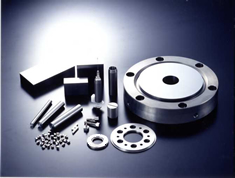Tungsten Heavy Alloy Facts
Tungsten Heavy Alloy Abstract
The name "tungsten" is derived from the Swedish term meaning "heavy stone". Tungsten facts has been assigned the chemical symbol W after its German name wolfram. Tungsten facts has the highest melting point (3410°C or 6170°F) of all metals. The extremely high melting point of pure tungsten makes all the common manufacturing techniques used for metals such as iron impractical.

Specialized methods make tungsten heavy alloy possible for the processing of pure tungsten into rod, sheet, and wire for a wide variety of high temperature applications including incandescent lamp wire, TIG welding electrodes, and high temperature heat shielding.
Another important industrial property of tungsten is its high density of 19.3 g/cc (0.70 lbs/in3). In addition to high gravimetric density, its high radiographic density makes it an ideal material for shielding or collimating energetic x- and γ-radiation. For such applications, tungsten is commonly alloyed in order to circumvent the extremely high processing temperatures that would otherwise be required to melt and cast the pure metal.
Tungsten Facts of Tungsten Heavy Alloy
Tungsten heavy alloy (WHA) is ideally suited to a wide range of density applications, offering a density approaching that of pure tungsten but without the very costly processing and inherent size and shape limitations of the former.
Tungsten heavy alloy is produced by a powder metallurgy (P/M) technique known as liquid phase sintering (LPS), in which completely dense, fully alloyed parts are formed from pressed metal powders at a temperature less than half the melting point of pure tungsten. While sintered steel and copper alloy parts commonly contain significant residual porosity that may require polymeric infiltrants to seal, sintered WHA have a nonporous surface. Tungsten heavy alloy has excellent radiation resistance, thermal and electric conductivities, corrosion resistance and is also machinable.
Tungsten heavy alloy parts are manufactured from very fine, high purity metal powders – typically tungsten, nickel, and iron. The blended metal powder is compacted under high pressure (up to 30 ksi) to form a specific shape that is very close to the geometry of the final part. By utilizing this near net shape forming approach, economy is realized by the elimination of excess material and the time and energy necessary to remove unwanted stock from mill shapes.
Tungsten heavy alloy provide a unique combination of density, mechanical strength, machinability, corrosion resistance, and economy. Consequently, WHAs are widely used for counterweights, inertial masses, radiation shielding, sporting goods, and ordnance products. These versatile materials provide distinct advantages when compared to alternate high density materials, as seen in the Table 1.
Pressed parts are then subjected to high temperature sintering in hydrogen. As the parts are slowly heated, the hydrogen reduces metal oxides present and provides a clean, active surface on each of the very small metal particles. As the temperature increases further, chemical diffusion takes place between particles. Neck growth occurs between particles, and surface energy drives pore elimination and part densification.
Tungsten Facts of Tungsten Heavy Alloy Spheroidized Microstructure
The pressed section shrinks uniformly, with about 20% linear shrinkage (equating to approximately 50% volumetric shrinkage) being typical. Once the temperature is sufficiently high to form the liquid phase, any remaining densification occurs very quickly as the alloy assumes a "spheroidized" microstructure by a mechanism know as Ostwald Ripening. The sintered structure of a common commercial WHA is two-phase, consisting of a linked network of tungsten spheroids contained in the ductile matrix phase.
The spheroidized microstructure is typical for most commercial WHA products. The rounded phase (~30-60 μm in diameter) is essentially pure tungsten, which is surrounded by a metallic nickel-iron binder phase containing some dissolved tungsten. This structure provides the maximum mechanical properties for a given alloy composition. Through the process of pressing and LPS, metal powders are transformed into fully dense shapes that are very close to the dimensions of the finished parts
If you have any interest in tungsten facts, please feel free to contact us by email: sales@chinatungsten.com, sales@xiamentungsten.com or by telephone: +86 592 5129696.






 sales@chinatungsten.com
sales@chinatungsten.com